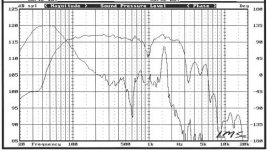When you make a nearfield frequency response measurement of the speaker of a bass reflex enclosure, you can tell the resonant frequency of the box. As it reaches its resonant frequency, the speaker will decrease it's movement and the port will take some of the load. This will show up as a dip in the response, like in the following example :
Here is a typical nearfield response of the speaker of a bass reflex enclosure (microphone placed very close to the speaker) : Imgur: The most awesome images on the Internet
Here is the nearfield response of my enclosure : Imgur: The most awesome images on the Internet
Again, the graphs show the nearfield measurement of the speaker, not the box as a whole. For that the port needs to be measured as well and added up.
Where is the dip? Why there is no reduction in woofer movement at resonance? I measured the impedance of the speaker-box system and I know that the resonant frequency is at 28 Hz. But why doesn't this show up in the nearfield frequency response chart?
Here is a typical nearfield response of the speaker of a bass reflex enclosure (microphone placed very close to the speaker) : Imgur: The most awesome images on the Internet
Here is the nearfield response of my enclosure : Imgur: The most awesome images on the Internet
Again, the graphs show the nearfield measurement of the speaker, not the box as a whole. For that the port needs to be measured as well and added up.
Where is the dip? Why there is no reduction in woofer movement at resonance? I measured the impedance of the speaker-box system and I know that the resonant frequency is at 28 Hz. But why doesn't this show up in the nearfield frequency response chart?
Please tell us at what frequency did you tune thebox.
Also run an impedance check, the curve will show you the impedance dip more clearly than any acoustic measurement.
Also run an impedance check, the curve will show you the impedance dip more clearly than any acoustic measurement.
I tuned it to 31 Hz. After doing an impedance sweep the resonance is actually at 28 Hz.
My question is not what is the resonant frequency of my box. The question is why don't I have a dip in the nearfield measurement? What does that mean?
My question is not what is the resonant frequency of my box. The question is why don't I have a dip in the nearfield measurement? What does that mean?
Place the mic almost touching the cone. Adjust it so that when it vibrates most, it doesn't touch the mic.
Frankly, I wouldn't worry about your measurement. Near field is not used to identify resonance. What you want is to measure the port. Stick your mic at the mouth of the port. You will get a peak (see attachment below). After that comes merging the port output with the near field.
Frankly, I wouldn't worry about your measurement. Near field is not used to identify resonance. What you want is to measure the port. Stick your mic at the mouth of the port. You will get a peak (see attachment below). After that comes merging the port output with the near field.
Attachments
I moved the mic as close as possible and still no obvious dip. As far as I know, using a mic to determine the resonant frequency of the box is the most accurate way, since the result is not corrupted by the inductance of the coil (like with the impedance chart).
Maybe your measurement/data isn't capturing the dip. What's the frequency resolution of your measurement? Length of signal before FFT? Data smoothing? The dip should be there if it's a proper BR system.
I tuned it to 31 Hz. After doing an impedance sweep the resonance is actually at 28 Hz.
My question is not what is the resonant frequency of my box. The question is why don't I have a dip in the nearfield measurement? What does that mean?
No dips means high losses.
I didn't apply silicone adhesive around the bass reflex ports because it was at an awkward angle an hard to reach inside the box. My guess is I have some losses there for sure. I'll try to seal it up and see what results I get.
Have you checked the enclosure is absolutely air-tight? Block the port firmly ( I use a a firmly clamped piece of board with isolation strip) and check whether the woofer comes back very slowly when pushed in. You d be surprised how often an enclosure is not air tight.
Good Luck,
Eelco
Good Luck,
Eelco
- Status
- Not open for further replies.
- Home
- Design & Build
- Software Tools
- Nearfield response measurement
